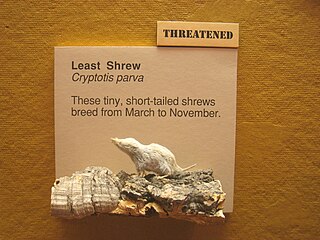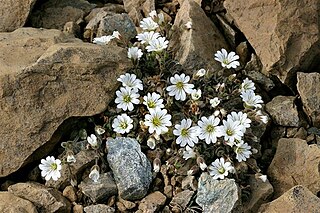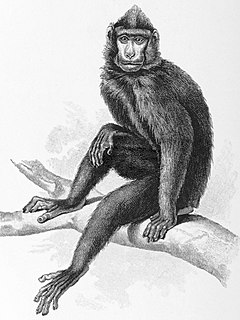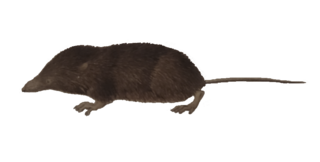
An argus, or argus pheasant, is a member of a clade in the tribe Pavonini of the family Phasianidae, containing two species of bird that are closely related to peafowl. It has hundreds or thousands of tiny white spots on its plumage pattern, and thus its naming might have been in reference to the mythical hundred-eyed giant, Argus Panoptes.

Centropomus is a genus of predominantly marine fish comprising the family Centropomidae. The type species is Centropomus undecimalis, the common snook. Commonly known as snooks or róbalos, the Centropomus species are native to tropical and subtropical waters of the western Atlantic and eastern Pacific Oceans.

The black-throated gray warbler or black-throated grey warbler is a passerine bird of the New World warbler family Parulidae. It is 13 cm (5.1 in) long and has gray and white plumage with black markings. The male has the bold black throat of its name, and black stripes on its head, as well as black streaks on its flanks; the female is a paler version of the male, with a white throat and less distinct black markings on the flanks and wings. It breeds in western North America from British Columbia to New Mexico, and winters in Mexico and the southwestern United States. The habitats it prefers are coniferous and mixed forests and scrubland, especially those with pinyon pines, junipers, sagebrush, and oaks. Its nest is an open cup of plant fibers lined with feathers, built a few metres from the ground in the branches of a tree or shrub. Three to five eggs are laid, and young are fed by both parents. Common in its breeding range, it does not seem to be seriously threatened by human activities, unlike many migratory warblers.

The genus Cryptotis is a group of relatively small shrews with short ears, which are usually not visible, and short tails, commonly called small-eared shrews. They have 30 teeth and are members of the red-toothed shrew subfamily. Since 1992, Neal Woodman at the United States National Museum has been in the process of revising the genus. To date, this has resulted in an increase in the number of species from 12 to 30.

Cerastium nigrescens, commonly known as the Shetland mouse-ear, Shetland mouse-eared chickweed or Edmondston's chickweed, is an endemic flowering plant found in Shetland, Scotland.

The St. Johns National Wildlife Refuge is part of the United States National Wildlife Refuge System, located off SR 50 just west of Titusville. The 6,255 acre (25 km2) refuge was established in 1971 to protect the now extinct dusky seaside sparrow, Ammodramus maritimus nigrescens. It is administered as part of Merritt Island National Wildlife Refuge.
The American Elm cultivar Ulmus americana 'Nigricans'Dieck was cloned from a selection made from seedlings raised by the Zöschener Baumschule, Zöschen, Germany, and listed by Georg Dieck with a brief description in Haupt-catalog der Obst- und gehölzbaumschulen des ritterguts Zöschen bei Merseburg, 1885.

Trifolium nigrescens, the small white clover, is an annual species which is widespread around the Mediterranean, including north Africa, and the Middle East.
The elm cultivar Ulmus 'Nigrescens' was identified by Pynaert as Ulmus campestris betulaefolia nigrescens. Considered by Green to be "probably Ulmus carpinifolia , but said to have been raised from seed of Purpurea".

The dark sheath-tailed bat is a species of sac-winged bat in the family Emballonuridae. It is the only species in the genus Mosia.

The blackish antbird is a species of passerine bird in the family Thamnophilidae. It is found in Bolivia, Brazil, Colombia, Ecuador, French Guiana, Peru, and Suriname. Its natural habitats are subtropical or tropical moist lowland forests, subtropical or tropical moist montane forests, and heavily degraded former forest.

The black pitohui is a species of bird in the monotypic genus of Melanorectes in the family Pachycephalidae. It is found throughout the highlands of New Guinea. Its natural habitat is subtropical or tropical moist lowland forests.

The Gorontalo macaque or Dumoga-bone macaque is a species of primate in the family Cercopithecidae. It is endemic to the island of Sulawesi in Indonesia.

The blackish small-eared shrew is a species of shrew in the family Soricidae. It is found in parts of Costa Rica, El Salvador, Guatemala, Honduras, Mexico, and Panama. An example specific habitat is the Petenes mangroves of the Yucatán.

The Himalayan shrew is found in Bhutan, China, India, Myanmar, and Nepal, is currently the only species in the genus Soriculus within the tribe Nectogalini, although the species Chodsigoa and Episoriculus, which occur in southeastern Asia, as well as those of the fossil European genus Asoriculus, were formerly included there.

The swift fruit bat is a species of megabat in the family Pteropodidae.
Thoopterus is a genus of megabat. It has two species:
A xerophile is an extremophilic organism that can grow and reproduce in conditions with a low availability of water, also known as water activity. Water activity (aw) is measured as the humidity above a substance relative to the humidity above pure water. Xerophiles are "xerotolerant", meaning tolerant of dry conditions. They can often survive in environments with water activity below 0.8; above which is typical for most life on Earth. Typically xerotolerance is used with respect to matric drying, where a substance has a low water concentration. These environments include arid desert soils. The term osmotolerance is typically applied to organisms that can grow in solutions with high solute concentrations, such as halophiles.

Senegalia nigrescens, the knobthorn, is a deciduous African tree, growing up to 18 m tall, that is found in savanna regions from West Africa to South Africa. The tree is resistant to drought, not resistant to frost and its hard wood is resistant to termites. Giraffes often browse on the flowers and foliage of this tree, while the seed pods and foliage are browsed on by a range of mammals, including elephants.
The elm cultivar Ulmus 'Betulaefolia Nigrescens', the Black Birch-leaved Elm, reportedly a seedling of a purplish-leaved elm, was first described by Pynaert in 1879 as U. campestris betulaefolia nigrescens. An U. campestris betulaefolia nigrescensHort. was distributed by the Späth nursery, Berlin, in the 1890s and early 1900s.














